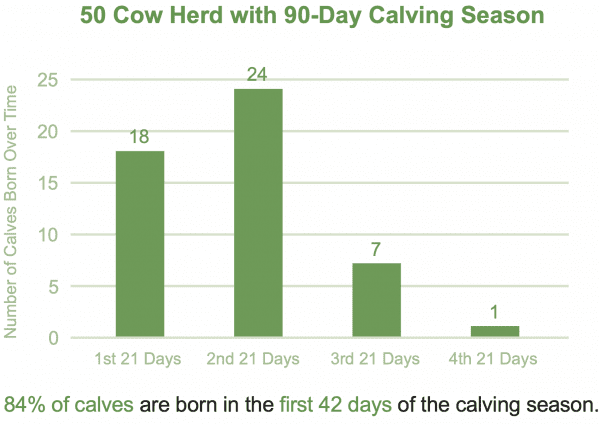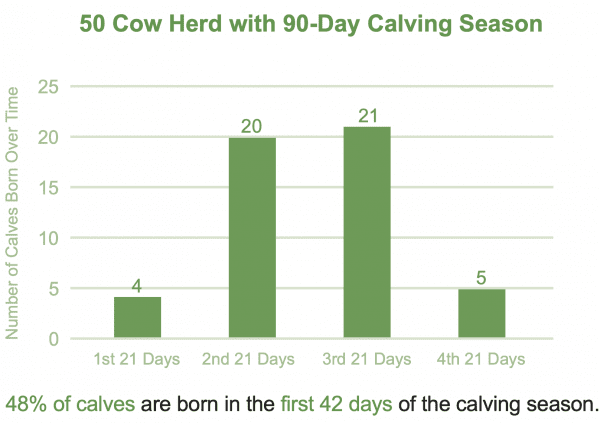Source: Alabama Cooperative Extension System
The success of a beef cow-calf operation depends on the number of calves produced and marketed each year. Fewer calves to market will reduce gross income and negatively affect profitability.
Reproductive performance can potentially increase or decrease overall profitability. Proper management is crucial. Optimum nutrition, proper herd health, and accurate record keeping are vital contributions that can affect reproduction in a cow herd.
General Reproductive Goals for Cow-Calf Operations
Reproductive goals for a cow-calf operation include the following:
- Target a defined calving season of 60 to 90 days or fewer. (See “Transitioning to a Defined Calving Season,” ANR-2656, on the Extension website.)
- Be productive to reach high pregnancy and calving percentages and an optimal herd average calf weaning weight. (See “Beef Cattle Record Keeping Basics,” ANR-2488, on the Extension website).
- Be efficient to maintain cows who consistently produce a calf each year and strive for a high percentage of calves born in the first half of the calving season.
Management Tools for Optimizing Reproduction
Nutrition
Proper nutrition management is vital for success in reproduction. Nutritional requirements change for cows and heifers in each reproductive phase, which includes breeding, pregnancy, calving, lactating, and rebreeding. (See “Nutrient Requirements of Beef Cattle,” ANR-0060, on the Extension website). Insufficient nutrition can result in many reproductive problems, such as suppressed fertility, lower pregnancy percentages, and delayed breeding to extend the calving season. Observing body condition scores (BCS) is an effective practice to monitor relative body fat and energy stores in managing nutrition. (See table 11 under Nutritional Management in the “Alabama Beef Handbook,” ANR-1323, on the Extension website.)
Replacement heifer development is also fundamental to achieving reproductive goals. Heifers reach puberty on average at 10 to 12 months of age, but this is influenced by age, weight, and breed composition. It is ideal to develop heifers at a growth rate of 1.0 to 1.5 pounds per day from weaning to breeding (See “Nutritional Management of Beef Heifers,” ANR-2597, on the Extension website). Time first breeding when a heifer reaches 65 percent of her mature body weight and with the goal of calving at 2 years of age. A heifer is still growing at this age so plan to breed 20 to 30 days before mature cows to allow for nutritional management and more time to successfully rebreed.
Herd Health
A comprehensive herd health program is critical for reproductive performance. Vaccination programs for beef cattle herds are designed to protect animals from diseases caused by infectious organisms (See “Vaccinations for the Beef Cattle Herd, ANR-0968, on the Extension website). Infectious diseases of cows, heifers, and bulls can result in reproductive problems such as infertility or spontaneous abortion. Establish a working relationship with a local veterinarian to develop and implement a complete herd health program.
Effective reproductive management also includes basic knowledge of a cow’s or heifer’s reproductive system. The estrous cycle is the time from one estrus to the next and averages 21 days in cattle. Estrus is the visual sign of the beginning of an estrous cycle and is defined as when a cow or heifer is receptive for breeding (see pages 78 and 79 in the “Alabama Beef Handbook”). A nonpregnant cow or heifer can potentially conceive a calf with each estrous cycle. Once conception occurs, gestation (or pregnancy) averages 283 days. After the completion of the breeding season, pregnancy status can be determined by transrectal palpation, transrectal ultrasonography, or blood testing (see “Beef Cow Pregnancy Examination,” ANR-1417).
Breeding soundness exams for replacement heifers are used to evaluate a heifer’s reproductive potential to successfully become pregnant. These breeding exams consist of reproductive tract scores and pelvic area measurements to assess a heifer’s readiness for breeding (see “Breeding Soundness Examination for Replacement Heifers,” ANR-2263). Perform heifer breeding soundness exams one month before breeding. This allows for retaining the most reproductively sound heifers and culling (or removing) unsound heifers.
Performing an annual bull breeding soundness exam (BSE) is also critical. A BSE assesses a bull’s ability to sire a high percentage of calves within a defined calving season. A BSE evaluates a bull’s mobility, structural soundness, internal and external reproductive tract, scrotal circumference, and semen quality (see “Bull Breeding Soundness Examinations,” ANR-1335). Bulls will be classified as either a satisfactory, unsatisfactory, or deferred breeder. Deferred breeders will need to be reevaluated. Perform bull BSEs at least 60 days before each breeding season. This allows time for any unsatisfactory bulls to be replaced and any deferred bulls to be reexamined.
Whole Herd Reproductive Metrics
Whole herd record keeping provides an overall assessment of reproductive performance. After pregnancy status has been determined, pregnancy percentage can be calculated as a first indication of reproductive efficiency by dividing the number of pregnant females by the number of females exposed during the breeding season. After the calving season, calculate a calving percentage by dividing the number of females who calved by the number of females exposed to provide an appraisal of calf death loss due to any calving or reproductive health problems (see “Beef Cattle Record Keeping Basics, ANR-2488).
A calving distribution is useful to review when most calves were born within a defined 90-day calving season. To do so, record the date when the first calf was born. At the end of the first 21 days of calving, count and record the number of calves born. Continue counting and recording the number of calves born within each additional 21-day calving period. Illustrate or determine your calving distribution by reviewing the number of calves born in each 21-day period of the 90-day calving season (figure 1). As an indicator of reproductive efficiency, it is ideal for a high percentage of calves to have been born in the first half of the calving season (figure 1). Cow herds with a lower percentage of calves born in the first half of the calving season are less efficient (figure 2).

Figure 1. Efficient calving distribution.

Figure 2. Less efficient calving distribution.
Individual Animal Reproductive Metrics
Individual animal record keeping provides a more precise evaluation for reproductive performance and efficiency. Each cow’s and heifer’s reproductive performance can be recorded over multiple breeding and calving seasons and evaluated with individual reproductive metrics. Individual animal record keeping involves recording information for each animal such as animal identification, birth date, calf sex, calf birth date, calf weaning weight, and more (See “Beef Cattle Record Keeping Basics,” ANR-2488). Over time, a cow’s performance can be measured by average calving interval or the average number of days between one calving date to the next. An ideal average calving interval is 370 days or less. The value of an average calving interval will increase if a cow has missed or lost a calf. Cows with an average calving interval value of 370 days or less are reproductively efficient, and cows with high- value calving intervals are less efficient and should be culled (or removed) from the herd (table 1).
Table 1. Individual Cow Record Examples for Average Calving Interval
| Cow A | Cow B |
|---|---|
| Born in 2010 | Born in 2010 |
| 9 calves produced | 6 calves produced |
| Average calving interval: 368 days | Average calving interval: 446 days |
| Active in cow herd | Culled (or removed from the cow herd) |
Another individual animal metric to evaluate cow performance is the Most Probable Producing Ability (MPPA) ratio. MPPA is a ratio to allow for an impartial in-herd comparison to assess performance of cows of various ages and number of calves. Data included in the calculation of MPPA includes the average 205-day adjusted weight ratio for all calves, number of calves produced, and the repeatability of weaning weight ratio. MPPA is an estimate to predict future productivity based on past performance for cows within a herd with a ratio value of 100 to represent the herd average.
Collectively evaluating all individual reproductive metrics is most effective in improving cow herd reproductive performance. Analyzing the average calving interval, MPPA value, and calf average 205-day adjusted weaning weight fully reveals a cow’s complete performance. To make sound management decisions in selecting which cows to cull (or remove) from the cow herd, review a cow’s complete performance record (table 2). Culling (or removing) cows who do not perform allows for concentration of available resources for cows who do perform to improve a cow herd’s productivity and efficiency.
Table 2. Individual Cow Record Examples for Reproductive Metrics
| Metrics Recorded | Cow A | Cow B | Cow C |
|---|---|---|---|
| Date of Birth | 2010 | 2014 | 2010 |
| Number of Calves Produced | 9 | 5 | 4 |
| Average 205-Day Weaning Weight (lb) | 681 | 573 | 496 |
| Most Probable Producing Ability (MPPA) | 104 | 90 | 97 |
| Average Calving Interval (d) | 370 | 366 | 392 |
| Outcome: Active or Removed | Active | Active | Removed |
Summary
Reproductive performance is significant for success in beef cattle production. To be productive and efficient in reproduction, proper management and record keeping are crucial.









